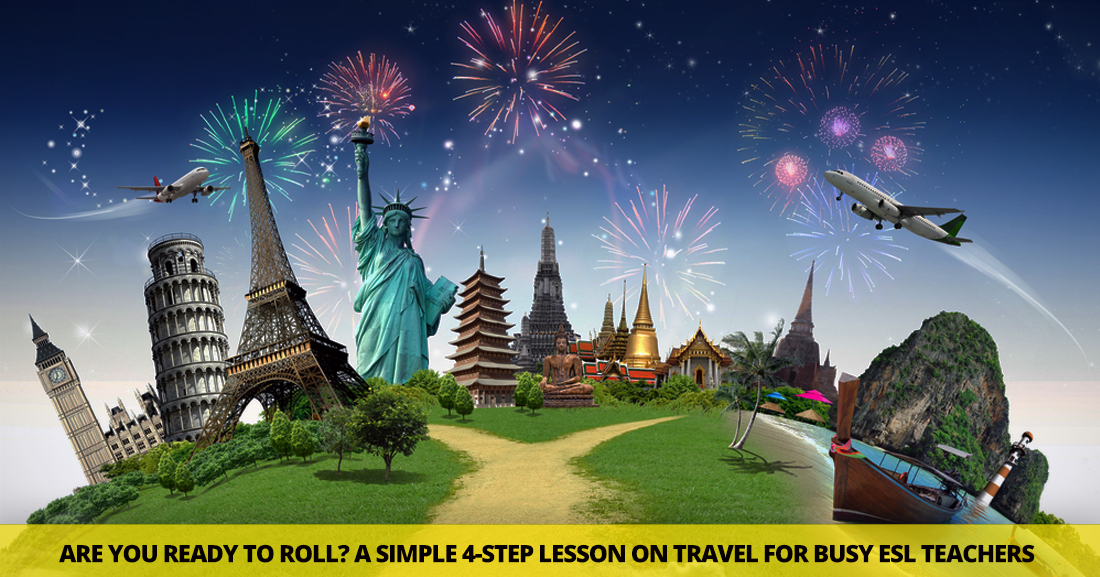☛ You Can Get There from Here: The Keys to Teaching Your Students to Give Directions


Travel! Students studying English overseas have all travelled from their home countries to study English abroad. You may teach English overseas rather than working with ESL students in your home country. In that case, your students may not have the experience with travel that internationals do, but that doesn’t mean this lesson on travel isn’t for you.
What follows is a simple unit on teaching about travel. It is very relatable for international students, and students studying English in their home countries will enjoy it as well. Best of all, it’s all outlined for you. Just take the framework, put a few of your unique spins on it, and you will be ready to walk into the classroom and teach.
Before you introduce anything new in the travel department, give your students a chance to talk about what they already know. I love to do discussion groups at the start of any lesson. It gives students a chance to share their experiences, get to know their classmates better, and remember what they already know about a topic. It also gives me a read on how much they already know and where I may need to emphasize different areas of my lesson.
To start your lesson with discussion, try asking your students the following questions and let them talk about them with a partner or a couple of other students.
As students are discussing these questions, they may run into the need for certain grammatical structures. When talking about places they have already been, native speakers will naturally use the present perfect. If you haven’t taught your students this tense, take a moment to do it before giving them the questions or in the midst of their discussion.
When talking about where students would like to go, it may benefit your class to do a review of modal verbs and how to talk about their desires – e.g. where they would like to go, where they might like to go, where they could go…
After the initial discussion, I like to move on to a vocabulary activity. At this point, students have remembered much of what they already knew about the ways to get around, so I do a class brainstorm. I might ask them to give me as many different modes of travel as they can. I encourage students to be creative, including everything from razor scooters to hot air balloons.
You don’t have to limit your discussion to modes of transportation, however. You can also do a general brainstorm of any words related to getting around. If you do this, you’ll have a more extensive vocabulary list. Try developing a word web to show how different words associated to travel relate to each other.
A fun activity to do after brainstorming your modes of travel is to play this simple game.
Start by reading reads a list of transportation modes, pausing briefly after each one. The items on your list should all have something in common. (They all have two wheels, they travel through the air, you need a license to use them, you have to purchase a ticket, etc.) When a student thinks they have figured out what the category is, they should call it out. If they get it right, award them a point and then try again with another list.
Change things up when you play the game again during another class period. This time give the category to your students and ask them to work in groups of three to list as many items that fit the category as they can in two minutes. When time is up, have each group read off their list. Any item on more than one group’s list should get crossed off everyone’s list. The group with the most items left over wins the round.
Another follow up vocabulary exercise, and one that’s super easy, is to take the Air Travel Quiz.
Your students have been thinking about travel quite a bit by this point. But how much do they really know? It’s time for some research and study. Have students read one or more article from a travel magazine. As they read, they should take notes on interesting places in that location or the special things that draw people to vacation there. Students can then use the info to write a brochure for that destination. Display the brochures or make copies for each of your students. Have them read what their classmates have written and decide, based on the information in the brochures, where they would like to visit on their next vacation.
Another fun way to use the vocabulary about travel they have learned is to have your students write directions to their house from your classroom. We’re not talking “Take the red eye to Seoul.” Have your students write extremely detailed directions starting from your classroom door to the outside of the building, what type of transportation they should take to the airport, and down to the detail of which house in their area belongs to them. Give bonus points to students who include four or more different modes of transportation in their directions. In fact, why not take a page from parkour and have students write the most complicated directions possible to their home, possibly including a hang glider and/or a rickshaw.
Take some time before students write their directions to talk about sequential order and some transitions that work between sequential steps. Then require your students to use those transitions between the steps in their directions.
Not many of us actually get to take a trip around the world, but that doesn’t mean we can’t think about one or even plan one. Have your students work with some maps and your list of transportation modes to plan the perfect journey around the world. They might want to plan their trip around some of the most remarkable places in world such as the seven wonders. Would your students rather take a camel past Egypt’s famous pyramids or see them from a crop duster? Encourage student to think creatively and plan their trip. Then give each person up to ten minutes in front of the class to present their ideal trip. After the presentation, give students a chance to ask questions of their classmates. If you like, take a vote at the end of all the presentations to see who would have the most company on their ideal travels.
Travel isn’t always fun and games, but this travel game is fun for your ESL students. Have students sit in a circle. One person starts the game by saying, “I’m going on a trip, and I’m bringing…” They should then say something beginning with the letter A that they would include in their suitcase. The second person repeats the phrase, but he must say what the first person said before adding his own item beginning with B. Play continues around the circle with each person taking the next letter of the alphabet. Each person must repeat what every other person in the circle is bringing before they add their own, all starting with the letters of the alphabet. Play until you get to the letter Z and see if anyone (or everyone) can list everything without making a mistake.
You may not teach in Vegas, but your student will love this speaking activity in which they get to roll the dice and take a chance. Give students a list of 6 discussion questions about travel such as those listed below. Every pair of students will need one die between them. One person rolls the die and then answers the question corresponding to the number that they rolled. After she answers, the second person rolls and answers his question. Then switch up partners and have students roll again. Students may end up answering the same question more than once, but they may also end up answering all of the questions depending on how they roll.
That’s all it takes to teach a fun and complete lesson on travel. Take these exercises or supplement with some of your favorites, and your students will enjoy talking about all the places they’ll go.